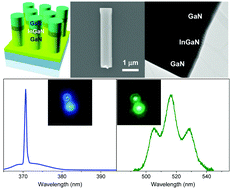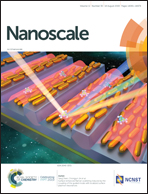Dual wavelength lasing of InGaN/GaN axial-heterostructure nanorod lasers†
Abstract
Optical confinement effects are investigated in InGaN/GaN axial-heterostructure nanolasers. Cylindrical nanorods with GaN/InGaN/GaN structures are prepared using combined processes of top-down and bottom-up approaches. The lasing of InGaN is observed at a low threshold (1 μJ cm−2), which is attributed to an efficient carrier transfer process from GaN to InGaN. The lasing of GaN is also found in the threshold range of 10–20 μJ cm−2 with a superlinear increase in emission intensity and high quality factors (Q = 1000), implying that dual wavelengths of lasing are tunable as a function of excitation intensity. The non-classical Fabry–Pérot modes suggest strong light–matter interactions in nanorods by optical confinement effects. The polarization of lasing indicates that the non-classical modes are in the identical transverse mode, which supports the formation of exciton–polaritons in nanorods. Polariton lasing in a single axial-heterostructure nanorod is observed for the first time, which proposes small-sized light sources with low threshold, polarized light, and tunable wavelengths in a single nanorod.



 Please wait while we load your content...
Please wait while we load your content...